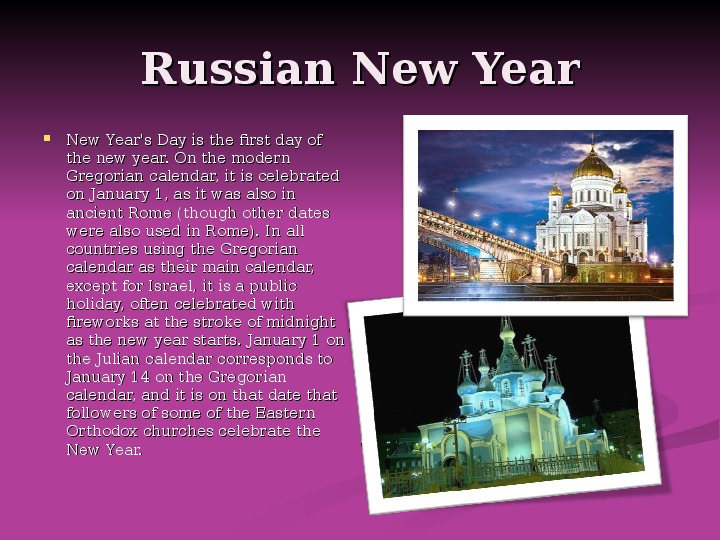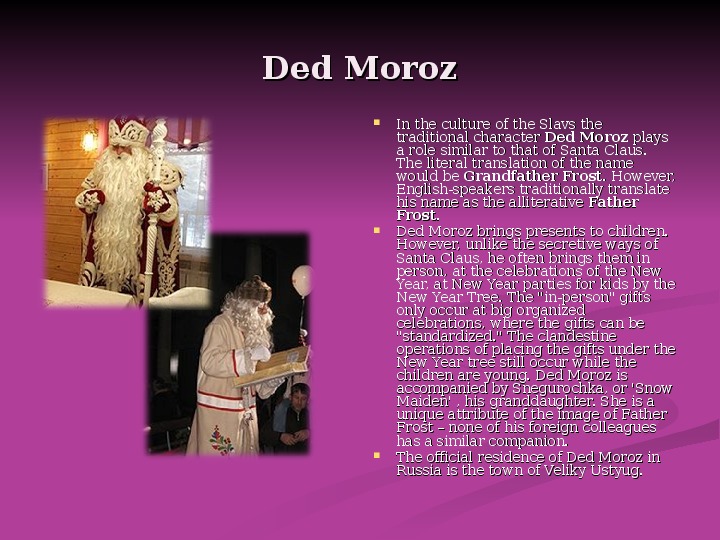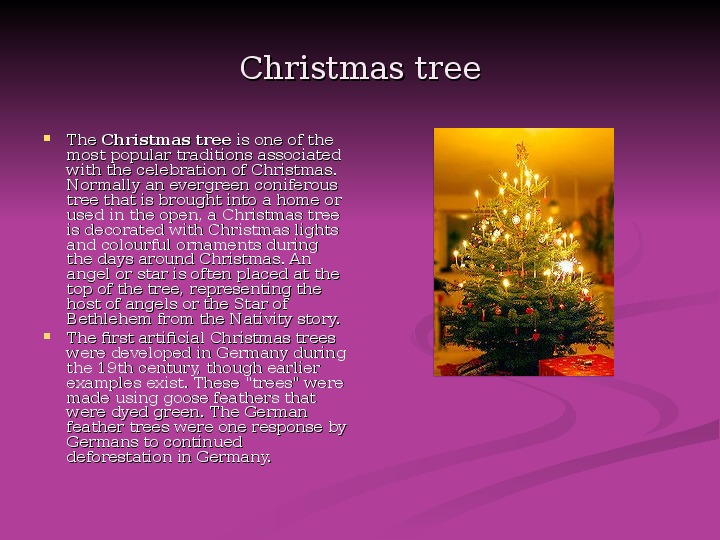Предназначена для урока по учебнику М.З. Биболетовой "Enjoy English" В презентации описана встреча нового года разными религиозными конфессиями. В качестве воспитательной цели можно указать толерантное отношение учащихся друг к другу, воспитание дружбы и взаимопонимания между представителями разных национальностей. Рекомендуется для учащихся в 8 классе

Christmas Day
Christmas Day Every country has its own customs and traditions. English
people are proud of their traditions and they keep them up. It is difficult
to speak about England without speaking about its holidays. Christmas
Day is among them. All English people celebrate Christmas (or X-mas) on
the 25th of December. Christmas! What kind of holiday is it? It is the
yearly celebration of the birth of Jesus Christ. It falls on December 25 by
the Catholic Church This holiday means the beginning of the new year
and the new life. English people celebrate this holiday with the
evergreen tree - Christmas tree. Children put a long sock, called a
Christmas stocking at the end of their beds and Santa Claus comes down
the chimney to bring them presents. Christmas Day is the greatest
holiday in England. It is interesting to visit the shops before this holiday.
There are a lot of nice Christmas cards and presents there. English
people like this holiday very much and prepare for it beforehand. They
buy presents for each other, try to send Christmas cards for their
relatives and friends. It is interesting to visit London during this holiday.
There is a Christmas tree in Trafalgar Square.

Russian New Year
Russian New Year
New Year's Day is the first day of
New Year's Day is the first day of
the new year. On the modern
the new year. On the modern
Gregorian calendar, it is celebrated
Gregorian calendar, it is celebrated
on January 1, as it was also in
on January 1, as it was also in
ancient Rome (though other dates
ancient Rome (though other dates
were also used in Rome). In all
were also used in Rome). In all
countries using the Gregorian
countries using the Gregorian
calendar as their main calendar,
calendar as their main calendar,
except for Israel, it is a public
except for Israel, it is a public
holiday, often celebrated with
holiday, often celebrated with
fireworks at the stroke of midnight
fireworks at the stroke of midnight
as the new year starts. January 1 on
as the new year starts. January 1 on
the Julian calendar corresponds to
the Julian calendar corresponds to
January 14 on the Gregorian
January 14 on the Gregorian
calendar, and it is on that date that
calendar, and it is on that date that
followers of some of the Eastern
followers of some of the Eastern
Orthodox churches celebrate the
Orthodox churches celebrate the
New Year.
New Year.
And then let us contunue. We can see many lights, toys and
sweets all over this tree. Everywhere you can see slogans A
Merry Christmas and a Happy New Year. The traditional
English dinner on Christmas is turkey and pudding.

Ded Moroz
Ded Moroz
Ded Moroz plays
plays
In the culture of the Slavs the
In the culture of the Slavs the
traditional character Ded Moroz
traditional character
a role similar to that of Santa Claus.
a role similar to that of Santa Claus.
The literal translation of the name
The literal translation of the name
Grandfather Frost. However,
would be Grandfather Frost
. However,
would be
English-speakers traditionally translate
English-speakers traditionally translate
Father
his name as the alliterative Father
his name as the alliterative
Frost..
Frost
Ded Moroz brings presents to children.
Ded Moroz brings presents to children.
However, unlike the secretive ways of
However, unlike the secretive ways of
Santa Claus, he often brings them in
Santa Claus, he often brings them in
person, at the celebrations of the New
person, at the celebrations of the New
Year, at New Year parties for kids by the
Year, at New Year parties for kids by the
New Year Tree. The "in-person" gifts
New Year Tree. The "in-person" gifts
only occur at big organized
only occur at big organized
celebrations, where the gifts can be
celebrations, where the gifts can be
"standardized." The clandestine
"standardized." The clandestine
operations of placing the gifts under the
operations of placing the gifts under the
New Year tree still occur while the
New Year tree still occur while the
children are young. Ded Moroz is
children are young. Ded Moroz is
accompanied by Snegurochka, or 'Snow
accompanied by Snegurochka, or 'Snow
Maiden' , his granddaughter. She is a
Maiden' , his granddaughter. She is a
unique attribute of the image of Father
unique attribute of the image of Father
Frost – none of his foreign colleagues
Frost – none of his foreign colleagues
has a similar companion.
has a similar companion.
The official residence of Ded Moroz in
The official residence of Ded Moroz in
Russia is the town of Veliky Ustyug.
Russia is the town of Veliky Ustyug.

Christmas tree
Christmas tree
The The Christmas tree
Christmas tree is one of the
is one of the
most popular traditions associated
most popular traditions associated
with the celebration of Christmas.
with the celebration of Christmas.
Normally an evergreen coniferous
Normally an evergreen coniferous
tree that is brought into a home or
tree that is brought into a home or
used in the open, a Christmas tree
used in the open, a Christmas tree
is decorated with Christmas lights
is decorated with Christmas lights
and colourful ornaments during
and colourful ornaments during
the days around Christmas. An
the days around Christmas. An
angel or star is often placed at the
angel or star is often placed at the
top of the tree, representing the
top of the tree, representing the
host of angels or the Star of
host of angels or the Star of
Bethlehem from the Nativity story.
Bethlehem from the Nativity story.
The first artificial Christmas trees
The first artificial Christmas trees
were developed in Germany during
were developed in Germany during
the 19th century, though earlier
the 19th century, though earlier
examples exist. These "trees" were
examples exist. These "trees" were
made using goose feathers that
made using goose feathers that
were dyed green. The German
The German
were dyed green.
feather trees were one response by
feather trees were one response by
Germans to continued
Germans to continued
deforestation in Germany.
deforestation in Germany.
Jingle bells
Dashing through the snow,,
Dashing through the snow
In a one-horse open sleigh,
In a one-horse open sleigh,
O'er the fields we go,
O'er the fields we go,
Laughing all the way.
Laughing all the way.
Bells on bobtail ring,
Bells on bobtail ring,
Making spirits bright.
Making spirits bright.
What fun it is to ride and sing,
What fun it is to ride and sing,
A sleighing song tonight.
A sleighing song tonight.
Oh, jingle bells, jingle bells,
Oh, jingle bells, jingle bells,
Jingle all the way,
Jingle all the way,
Oh, what fun it is to ride
Oh, what fun it is to ride
In a one-horse open sleigh.
In a one-horse open sleigh.
Jingle bells, jingle bells,
Jingle bells, jingle bells,
Oh, what fun it is to ride
Oh, what fun it is to ride
In a one-horse open sleigh.
In a one-horse open sleigh.
Jingle all the way,
Jingle all the way,
Nouruz
Nouruz
Nouruz (Persian: زورون /noʊruz/ ↔ [noʊɾuːz];
Turkish: Nevruz; Kurdish: Newroz;
with various local pronunciations and spellings,
meaning 'New Day') is the traditional Iranian
new year holiday celebrated by Iranian and
many other peoples in West Asia, Central Asia,
South.
Nouruz
Nouruz
Nouruz marks the first day of spring and the beginning of
the Iranian year. It is celebrated on the day of the
astronomical vernal equinox (the start of spring in the
northern hemisphere), which usually occurs on March 21
or the previous/following day depending on where it is
observed. As well as being a Zoroastrian holiday, it is also
a holy day for adherents of the Bahá'í Faith. In Iran it is
also referred to as an Eid festival, although it is not an
Islamic feast. Alamitos and Muslims also celebrate
Nouruz.
